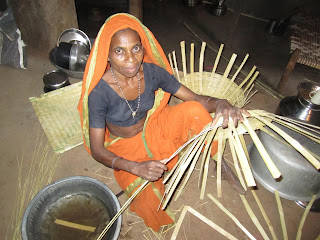Kotwalia: A
Particularly Vulnerable Tribal Group of Gujarat
About Kotwalia:
Kotwalia tribe is mainly distributed in the southern parts of Gujarat. Some
hold the view that Kotwalias are derived from Gamit tribe. They are also known
as Vitolia. Enthoven (1920) while writing about Vitolia says that they are also
known as Kotwalia and Wansphodia. They have the skill of preparing bamboo
articles. One of their traditional expert craftsman prepared a coat from bamboo
material and presented the same to a British Officer. That officer called him
by the name of Kotwalia or ‘coat wala’(Singh, 2003). They are the nomadic
group. The two clans of Kotwalia are Barodia and Wansphodia. The traditional occupation
of Kotwalia is making bamboo articles. In Gujarat bamboo is called ‘Wans’ and the process of breaking
them is known as ‘phodvu’ and hence combining these two words the name of
‘Wansphodia’ originates. It is believed that the Kotwalia used to work as gate
keeper or guard generally known as ‘Kotwal’, hence may be known as Kotwalia.
There
are four endogamous groups and exogamous kulas among the Kotwalia. The kulas
are Gamiti, Choudhary, Dhobi and Nai. The kul members consider their origin
from the same legendary ancestor. The kuls are of equal status, kul members
help each other at the time of crisis. According to their own perception, they
are lower than Rajput, Kunbi, etc. but higher than the Bhangi or Chamar. They
consider themselves equal to other tribal communities such as Kokna (Singh,
2003). The Kotwalias speak their own dialects among themselves and with
outsiders they speak Gujarati and often Hindi.
Kotwalia woman making baskets from bamboo strips
Settlement
Pattern: Kotwalia generally prefer to live in the forest and
its adjoining region on the banks of Tapi River in small hamlets so that they
could easily get their raw materials i.e. bamboo. Their hamlets are separated
and near to the other villagers so that they can sell their product and also
buy their required articles from the nearby markets. They themselves construct
their own houses with bamboo, wood and clay. Their huts were kachcha having
one, two or even three rooms sufficient for accommodate their family. They have
no bathrooms or sanitary facilities. During last few years, some pucca one room
tenements have been constructed for the people of this tribe under Tribal Area
Sub Plan- TASP. At some other places, the construction material- wooden
slippers, Manglore tiles for roof and bamboos have been provided to them for
upgrading their house or for construction of new but kuccha house (Upadhyaya
and Pancholi, 2010).
Inside view of their house
Food
Habits: They are generally non vegetarians. Their staple
food is nagali, a coarse millet. Roti, dal, rice, corn, etc. are their
main food items. They consume eggs, meat and fishes. Drinking of liquor and tea
are common and both male and female consume these. On festive occasion such as
marriage tadi (local made liquor) and
liquor are consumed freely. It is also said that they also used to eat the
flesh of dead animals which is left now.
Dress
and Ornaments: Old persons wear dhoti and kurta and also
large and free size of half pants and cover their head with turban. The youngsters
generally put on western dresses like pant, shirts, jackets and t- shirts. Women
generally put on saree with colourful blouse. Old women still wear ghagra and choli. They cover their head with a small piece of cloth known as chaniya. The old people both men and
women wear ear rings made up of silver. Old women wear ankle and toe fingers
rings and ornaments made of silver. They also wear chain, necklaces and black
thread around their neck. The married women wear Mangal Sutra and nose ring. The
Kotwalia settle their disputes among themselves under the supervision of the
elderly persons of their community. If they fail to settle their dispute, then
they go for police and very rarely they go to court.
A Kotwalia girl
A Kotwalia woman
Social
Life: The family types of Kotwalias are patriarchal and both
joint and nuclear. The family property is equally distributed among the sons
but the eldest son has the dominating status and authority. The women are not
allowed to claim the right on property. Although women enjoy status in
domestic, economic and ritual related matters and also take part in the social
gatherings. They also make contribution to the family income by helping their
husband in making baskets and other works.
A Kotwalia family
References:
-
Enthoven, R.E. 1920- “The Tribes Castes
of Bombay.” Bombay Govt. Central Press,
rept. Vol. II, 1975. Delhi: Cosmo Publications.
-
Singh, K.S. 2003- “People of India: Gujarat,
XXII, (2).” Anthropological Survey of
India. Mumbai: Popular Prakashan
Pvt. Ltd.
-
Upadhyaya, C. & Pancholi, R. 2010-“
Primitive Tribal Groups of Gujarat. A Baseline Survey.” Tribal Research and Training Institute, Gujarat Vidyapeeth, Ahmedabad.



















No comments:
Post a Comment